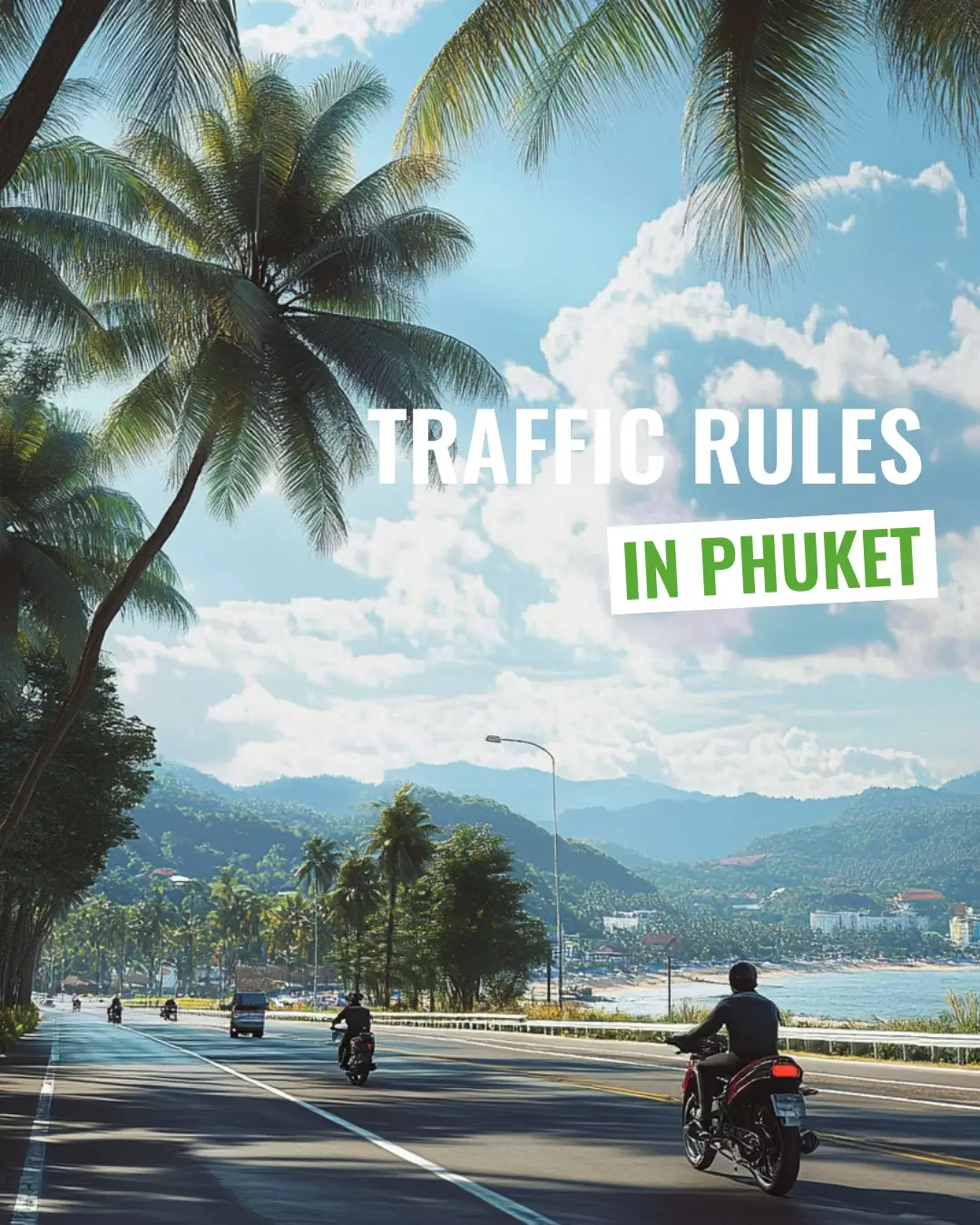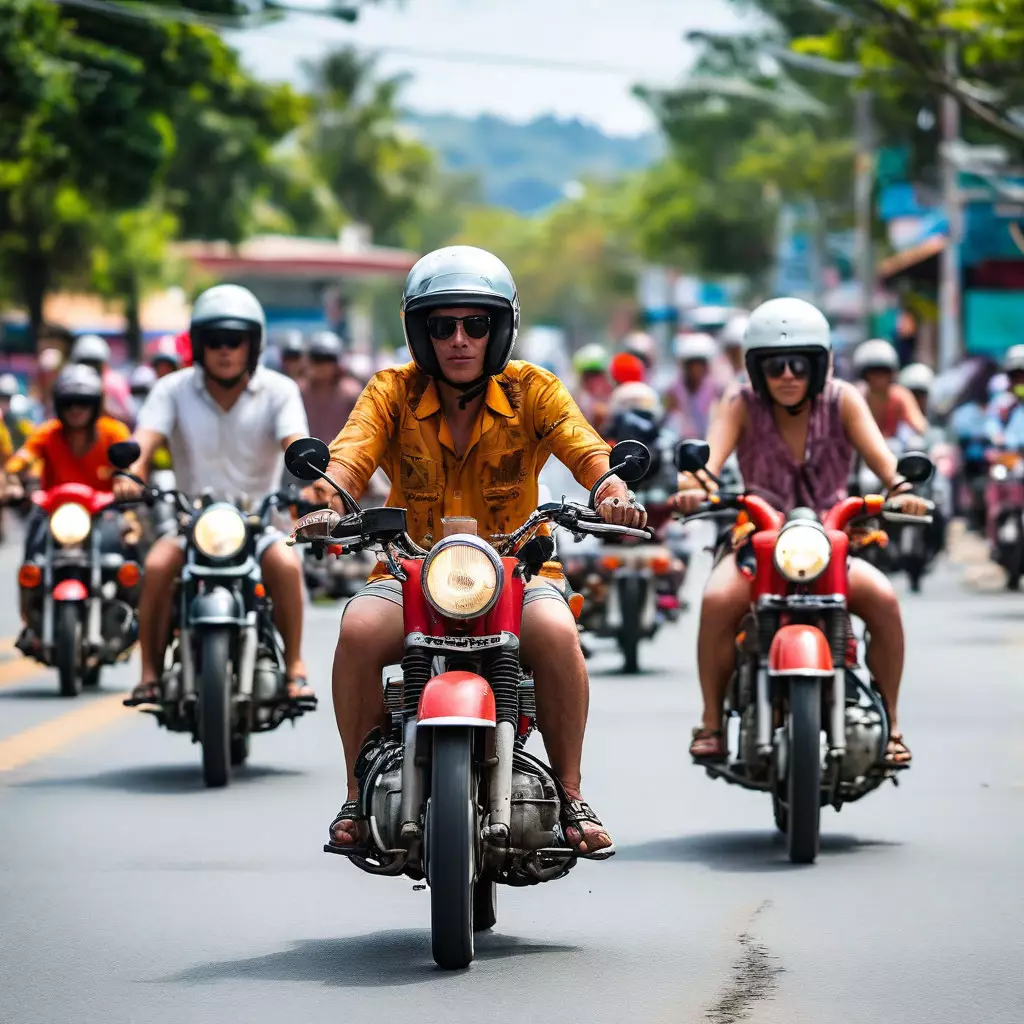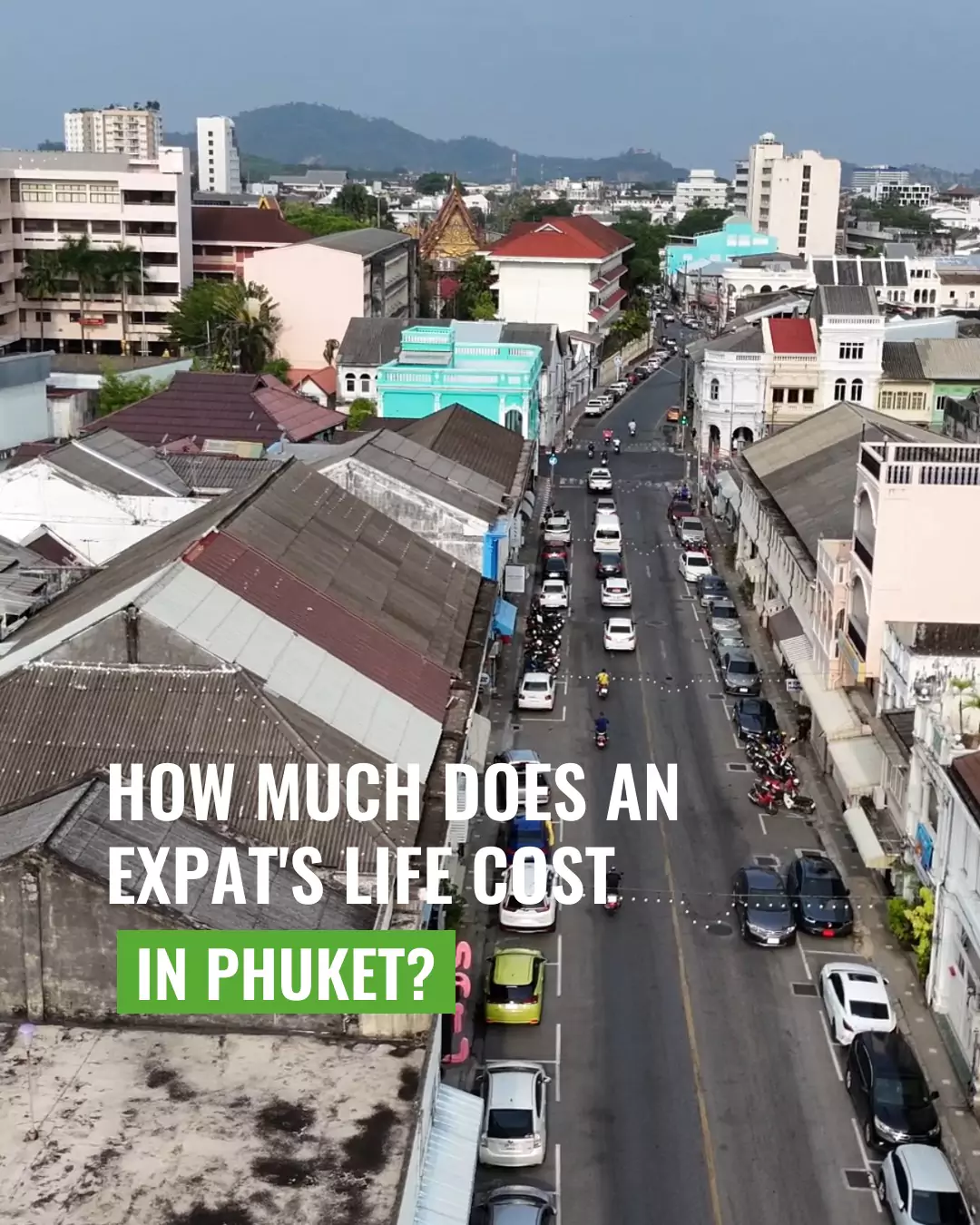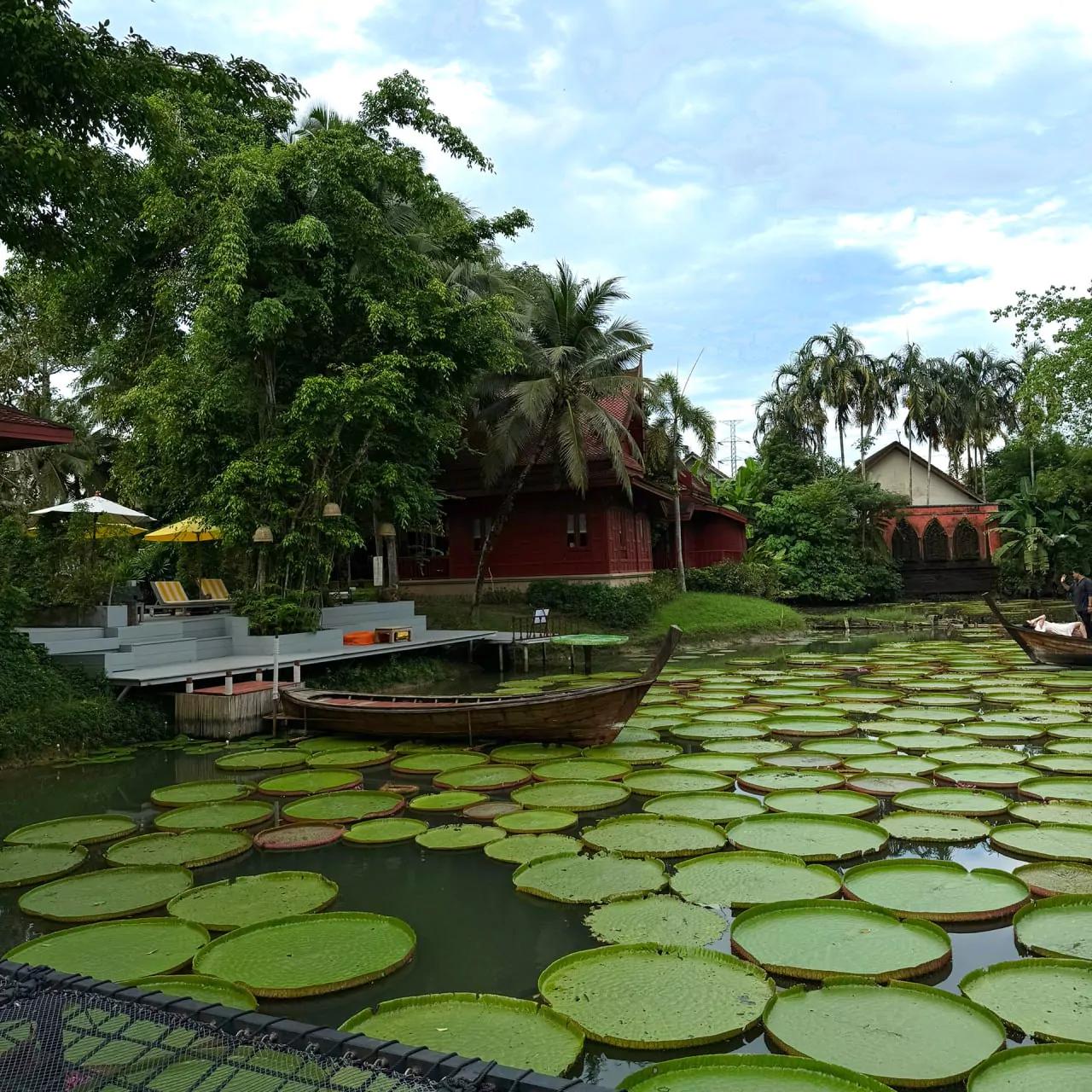Traffic Rules in Phuket
Traffic in Phuket can initially seem intimidating to many. However, drivers quickly adapt to left-hand traffic and the unique aspects of the Asian driving mentality. The driving style in Asia tends to be somewhat chaotic: locals maneuver their motorbikes as if other road users should anticipate their next move. It’s no surprise that people say, “Thais were born on motorbikes.” Foreigners, however, should exercise caution, stay alert, and remember the key traffic rules in Phuket.
- Keep to the left side of the road. All overtaking must be done on the right!
- Avoid driving in the far-left lane. Vehicles may be exiting from driveways, intersections, and parking lots, and they might not see you.
- At a T-junction, you can go straight in the left lane even on a red light, provided you don’t obstruct other traffic and/or if there is a corresponding sign.
- The first vehicle to enter an intersection has the right of way; others must yield.
- Pay attention to road markings. Be especially cautious about overtaking lanes and pedestrian crossings.
- Observe traffic lights carefully. At intersections, the green signal applies only to one lane, so turning left on red is permitted.
- You may cross a solid yellow center line, but only after yielding to all other road users.
- Flash your headlights if you want to be given the right of way. If you see someone flashing in your rearview mirror, it’s best to let them pass — otherwise, they may attempt a risky overtake.
- At roundabouts, priority is given to vehicles already in the roundabout. However, locals often ignore this rule, so stay prepared.
- If you need to stop suddenly, turn on your hazard lights. The car behind you will not attempt to overtake, preventing a dangerous situation.
- It can also be considered a rule to rent vehicles from companies that maintain their fleet well.
Another important question: In Thailand, does the right or left have the right of way?
This issue sparks a lot of debate since Thai traffic regulations do not explicitly define such a concept. Some sources claim that the left has the right of way because of left-hand traffic. However, in practice, both rules are applied depending on the specific situation.
The right-of-way rule applies mainly at intersections: when turning right or left, you must yield to vehicles coming from the right. In oncoming traffic situations, priority goes to the vehicle coming straight toward you, and only then can you make your turn. At equal-priority intersections, the rule is to yield to the vehicle on your right. However, in real life, drivers often rely on intuition.
It’s crucial to remember that other drivers may not know the rules or simply choose not to follow them. Additionally, an unspoken rule applies: the bigger or more expensive the vehicle, the more priority it tends to have — that’s just the local driving mentality.
The first few days of driving may feel unusual, but soon you’ll be able to move around Phuket more comfortably.
However, there are numerous traffic incidents involving tourists, so we strongly recommend arranging insurance in advance. It will ensure you receive timely medical assistance if needed.
We’ve found a reliable insurance company in Phuket for you. Fill out the form, and we’ll forward your request — they’ll contact you to provide details on the terms and pricing.
Safety should be a top priority. In Thailand, there are hefty fines for riding a motorbike without a helmet and for not wearing a seatbelt in a car.
Keep in mind that motorbikes are stopped for checks much more often than cars. Authorities may ask for your documents at any time, so make sure to have an international driver’s license in advance.
Another unique aspect of driving in Phuket is navigating hilly terrain. The maximum elevation is 529 meters above sea level — not very high, but still requiring some driving experience. With the stunning landscapes, you’ll likely want to visit scenic viewpoints, many of which are at higher elevations. In fact, we’ve gathered the best ones here.
What else to keep in mind when driving in Phuket:
- Speed limits: In urban areas, the speed limit is usually 40-50 km/h, while outside city limits, it ranges from 70-90 km/h. However, always pay attention to road signs, as speed limits may vary depending on the specific section of the road.
- Road conditions: Roads in Phuket can be narrow and winding, with unexpected turns and elevation changes. Be especially cautious when driving in the rain, as the surface can become slippery. Also, turn on your headlights during rainy conditions.
- Drinking and driving: The legal blood alcohol limit for drivers is 0.5‰. For drivers with less than five years of experience or those under 20 years old, the limit is 0.2‰. Violating this rule can result in severe fines or even imprisonment for driving under the influence of drugs.
- Using mobile phones: It is prohibited to use a mobile phone while driving unless you have a hands-free system. Violators may receive a fine.
- Parking: Pay attention to parking signs. Illegal parking can result in vehicle towing and fines.
- Pedestrian crossings: Drivers are required to yield to pedestrians. However, pedestrians should also remain cautious, as not all drivers adhere to this rule.
- High beam headlights: If an oncoming vehicle switches from high beams to low beams, it usually indicates that the driver is about to merge into the opposite lane. Pay close attention to these signals, as misunderstandings often lead to accidents.
- Car horn usage: Honking generally means the driver does not intend to slow down or give way. In such cases, it’s best to let the honking driver pass.
Can tourists obtain a Thai driver’s license? In short — yes, but not everyone. In Thailand, a tourist can officially obtain a local driver’s license only if they have a long-term legal basis for staying in the country, confirmed by proper documents.
The procedure varies slightly depending on whether you already have a driver’s license from your home country.
If you have a national driver’s license, you can exchange it for a Thai license without going through full training.
What you need:
- Passport + copies of all pages with visas/stamps
- Residence Certificate — issued by Immigration or obtained through your consulate
- Medical certificate from any Thai clinic
- Your national driver’s license + a copy
- English translation of your national license if it is not in English (some offices do not require this)
If you do NOT have any driver’s license, you will have to go through the full procedure, similar to a driving school:
- Enroll in a certified training center
- Attend theory classes (5–6 hours)
- Pass the written test
- Pass the practical driving test
- Receive your license
Important: without a verified address and a long-term visa, this option is usually not available to tourists.
What happens if you drive without a license
Driving without a license is one of the most common violations among tourists. It may seem minor, but the consequences can be serious — from fines to insurance issues and immigration problems.
- Fines
Police conduct regular checkpoints, especially in tourist areas of Phuket. Fines range from 500 baht.
- Deportation
Driving without a license alone does not lead to deportation, but it can cause problems if you are involved in a serious accident with injuries.
- Insurance does NOT apply
This is the most serious point, and many tourists don’t know it. If you drive without a license: your medical insurance will not cover accident-related injuries; you will have to pay for damages to other people’s property; you will also be responsible for medical expenses of injured parties.
- Court and criminal liability
If the accident is minor, it usually ends with fines. But if there are serious injuries or fatalities, it becomes a criminal case — and not having a license significantly worsens your liability.
- Vehicle confiscation
Police have the authority to temporarily seize your motorcycle or car, send it to an impound lot, and return it only after all fines are paid.
- Complications with future visas
For serious violations, police record the incident, which may cause additional questioning at future border crossings, visa extension issues, or even denial of re-entry.
We hope these rules help you better understand traffic in Phuket! Remember that having your own vehicle on the island will give you more freedom and allow you to see many more interesting places.


























